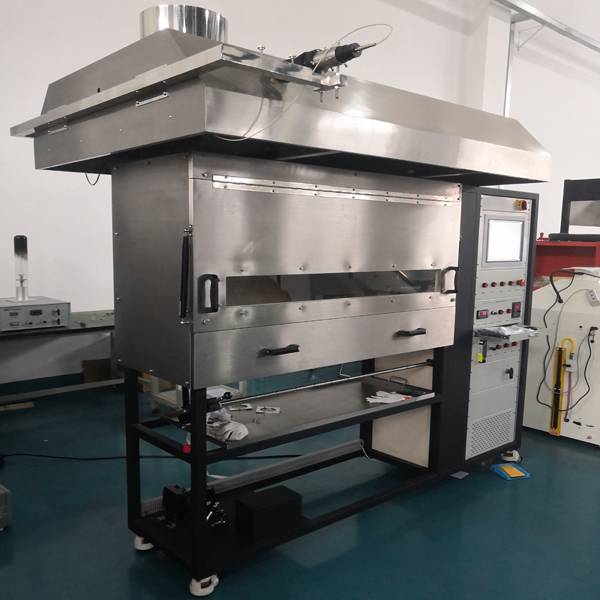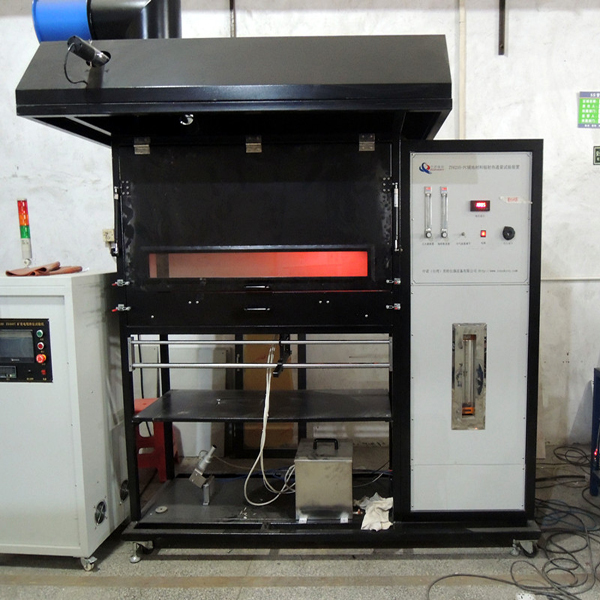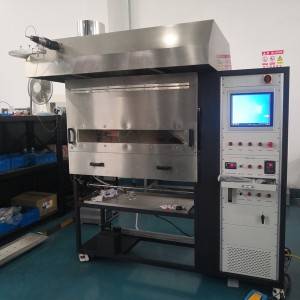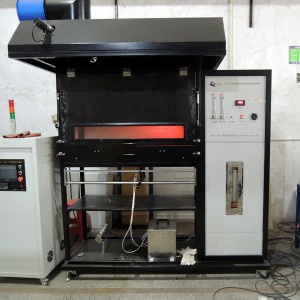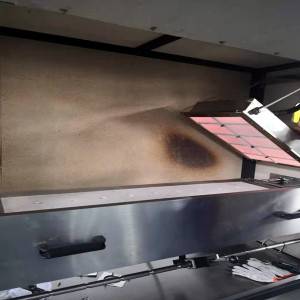EN ISO 9239-1 Radiant Flooring Panel Test Apparatus
Radiant Flooring Panel Test Apparatus Stainless Steel Hood with Smoke Measurement Ports
Product parameters (specifications)of the the Radiant Flooring Panel Test Apparatus
| Maximum operating power | 5kw |
| Timing accuracy | <1s / h |
| Heat flux meter Measuring range | (0-15) Kw / m2; (heat flow customer-owned) |
| Heat flux meter accuracy | ± 0.2Kw / m2 |
| Heat flux meter accuracy | <± 3%; |
| Heat radiation pyrometer range | 400-600 ℃, the accuracy of ± 0.5 ℃; |
| Black body temperature error | ± 5 ℃; |
| Smoke speed | (2.5 ± 0.2) m / s |
| Smoke capacity | (39-85) m3 / min |
| Porous refractory radiation board size | 300mm × 450mm, the ability of about 900 ℃ high temperature; |
| Thermocouple | diameter of 3.2mm K-type stainless steel armored thermocouple |
| Burning torch | diameter ¢ 10mm diameter ¢ 6mm, spray tube on the 35 ¢ 0.7mm hole |
| Flame height | 60 ~ 120mm adjustable |
| Ignition system | high voltage electronic ignition |
| Burning box size | L1420 * W1200 * H2300 (mm) |
| Strong exhaust system | the machine is equipped with a strong fan, when the test is completed, start the exhaust fan system will be exhausted outdoors |
Product introduction of the Radiant Flooring Panel Test Apparatus
The ISO 9239 Radiant Flooring Panel test is the cornerstone of the flooring materials reaction to fire tests in the Euroclass system. The test measures the spread of flame of the sample, under thermal exposure, using a radiant heat ignition source. The thermal exposure is that of a fire growing in the room of origin that through a door opening, radiates onto the floorings in an adjacent room or corridor. The apparatus can also be used for tests to standards ASTM E648 and DIN 4102; Part 14.
Use Environment
Indoor use
Altitude: up to 2000m
Ambient temperature: 10 to 35 ° C (60 to 85 ° F)
Relative humidity: 45%~75%.
Permitted voltage fluctuations: 10% of rated voltage.
Overvoltage rating: II
Pollution degree: 1
Product Feature and Application of the Radiant Flooring Panel Test Apparatus
1.The resulting test chamber is insulated with calcium silicate insulation board and is provided with a temperature resistant observation window.
2.The stainless steel sample support assembly is mounted on a sliding platform to allow safe and easy loading of the test sample.
3.The radiant heat is applied by means of a gas-fuelled panel, inclined at 30º, and directed at a horizontally mounted floor covering system specimen.
4.The radiant panel generates a radiant energy flux distribution ranging from a nominal maximum of 10.9 kW/m2 to a minimum of 1.1 kW/m2.
5.Dummy calibration specimen with holder, calibrated heat flux meter and mounting.
6.The distance burned until flame-out is reached and converted, by calibration, into an equivalent critical radiant flux, in kW/m2.
7.Heat Flux Meter: Range : 0 ~ 50 kw/m2; Surface emissivity :ε=0.95± 0.05
8.A smoke measuring system, according to DIN 50055, is mounted on a separate frame at the exhaust stack.
9.Control Rack for convenience in use, allowing observation of the apparatus and controls during equipment set-up and calibration.
10.Automatic ignition of the radiant panel and safety cut-out.
11.Automatic moving T type ignition burner
12.Stainless steel hood with smoke measurement ports.
Application:The FRP Flooring Radiant Panel Test Apparatus is an instrument that can be used to determine the equivalent thermal radiation of carpets, flooring materials, and roofing insulation materials that are laterally spread in the flame.
Product Details of the Radiant Flooring Panel Test Apparatus
The thermal radiation tester for paving materials is applied to the critical thermal radiation flux measurement of the ground covering material. The critical radiant flux refers to the incident heat per unit area. The greater the incident heat, the higher the heating amount required for the material, and the more stable the material. The less likely it is to catch fire. In the test device, a heat radiation source and a T-type burner are installed, and the farther away the sample is from the radiation source, the lower the heat radiation flux received on the surface, the sample is ignited by the T-type burner, and the test is performed. When the flame is extinguished, the damage distance of the sample, the corresponding heat radiation flux value, that is, the critical heat radiation flux.
The FRP Flooring Radiant Panel Test Apparatus meets the following test methods:
ISO 9239-1:Floor coverings - Fire reaction test - Part 1: Determination of flaming performance using radiant heat sources;
ASTM E648:The floor covering is subjected to a critical thermal radiation test using a thermal radiation source method;
GB/T 11785:Determination of the burning properties of flooring materials - radiant heat source method.
Dimension:1900mm (W) x 750mm x (H) x 2120mm (D)
Weight:235kg
Installation requirements
Installation size(mm)
Test box size::1800(L)*1500(W)*2400(H)
Electric control cabinet size:600(L)*1000(W)*1800(H)
Installation requirements
Power supply: 220 V±10%,50 Hz,5A
Air source requirements
Combustion gas: standard propane, the supply flow rate is not less than 5L/min, and the gas inlet pressure is not less than 0.15MPa;
Compressed air: the air force of the intake air is not less than 0.5MPa, and the flow rate is not less than 180L/min;
Water source: dedicated coolant for cooling the heat flow meter.
Electrical: 230 volts Nominal 10 Amps
Ambient Temperature: Operating 10°C to 35°C
Dimensions: Apparatus: 1900mm (W) x 750mm x (H) x 2120mm (D)
Gas Supplies: Propane and air compressor
Exhaust system requirements
Exhaust pipe: caliber 30cm, wind speed 2.5m / s, height from the ground is 2.4m.
What is the ISO 9239-1:2010?
ISO 9239-1:2010 specifies a method for testing the upwind combustion behavior and flame spread of horizontally installed floors exposed to heat flux radiation gradients in a laboratory, when ignited with a pilot flame.
This method works for all types of floors. Examples include textile carpets, cork, wood, rubber and plastic coverings and coatings. The results obtained by this method reflect the performance of the floor, including any substrates (if used). Modifications to the backing, adhesion to the substrate, other changes to the underlayment or floor may affect the test results.


